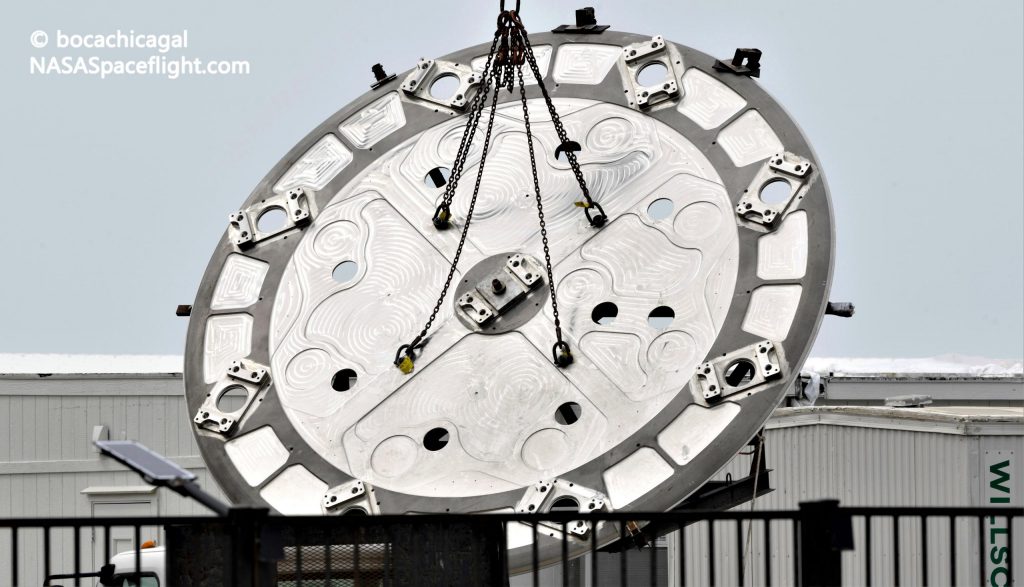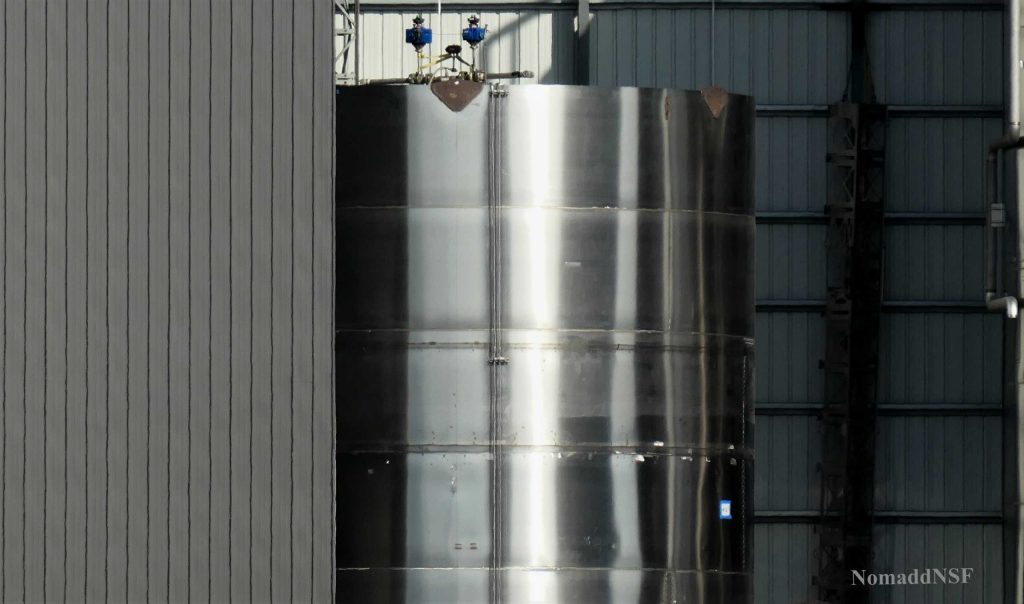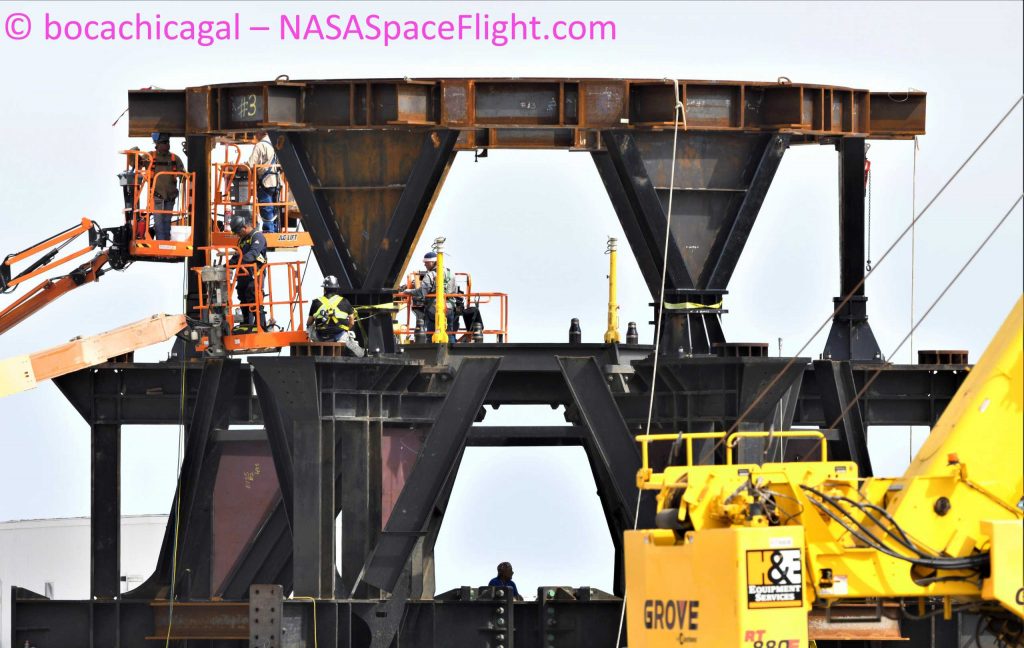

News
SpaceX first Super Heavy ‘test tank’ is almost ready for prime time
SpaceX has almost completed a ‘test tank’ meant to ensure that Starship’s Super Heavy booster is capable of withstanding the immense thrust of more than two-dozen Raptor engines.
Believed to be known as test tank BN2.1, the prototype’s latest appearance comes on the heels of news from CEO Elon Musk that SpaceX has upgraded Super Heavy with one extra Raptor engine – with plans to add another three down the road. The results of that tank’s imminent test campaign will likely be crucial as the company shifts its focus sending Starship to orbit (or close) as soon as possible.
Prior to a new Super Heavy booster ‘thrust puck’ design first spotted on May 29th, at least two separate booster engine section prototypes completed in the last few months sported an earlier variant more akin to a donut. At that point, Super Heavy’s design had a central cluster of eight gimballing, throttleable Raptors surrounded by a ring of 20 Raptor Boost (“RBoost”) engines – a variant meant to trade the ability to throttle for ~25% more thrust.

While Super Heavy booster BN1’s almost immediate scrapping – prior to a single test – guaranteed that major design changes were on the way, exactly what those changes would be was anyone’s guess. The appearance of a new booster ‘thrust puck’ design and Musk’s subsequent announcement that Super Heavy will “initially” have 29 – not 28 – Raptors likely mean that that engine section redesign was a major contributor to BN1’s instant obsolescence. The only other major change SpaceX clearly made with booster BN2 was switching the positions of its liquid methane and liquid oxygen tanks, ensuring that Super Heavy’s heavier oxidizer is closer to the rocket’s base.
Musk also stated that SpaceX will eventually upgrade Super Heavy to 32 engines, giving future boosters a central cluster of 12 engines that the SpaceX CEO says will significantly improve the efficiency of boostback burns.
With 29 identical Raptors, the simplest possible Super Heavy booster would produce up to 5800 tons (12.8M lbf) of thrust at liftoff. If SpaceX has already completed Raptor Boost’s design and qualification and kicked off mass production of a 250-mTf engine, that liftoff thrust climbs to 6800 tons (~15M lbf). If SpaceX achieves performance goals (~210 mTf stock; ~300 mTf RBoost) mentioned by Musk last year, a 32-engine Super Heavy could achieve peak liftoff thrust greater than 8500 metric tons (~18.7M lbf).
Even in its weakest configuration, Super Heavy will still be more than 60% more powerful than Saturn V and 25% more powerful than N1 – the largest rockets to have ever successfully or unsuccessfully flown. That immense thrust demands a structure capable of surviving those extreme forces while simultaneously feeding dozens of Raptors up to ~28 metric tons (~61,000 lb) of propellant every second and withstanding several thousand tons of liquid oxygen – all without leaking, cracking, or flexing too much.


While BN2.1 wont have any of the plumbing associated with dozens of Raptors, nine hydraulic rams will let SpaceX subject its Super Heavy thrust structure to the simulated thrust of some number of engines. Given the presence of nine rams and nine clustered engines, it’s unclear if BN2.1 will only test that main thrust structure or if those rams will somehow be spread out to simulate the thrust of a full 29 engines – 20 of which will instead transfer most or all of their thrust into Super Heavy’s skirt.
Regardless, if successful, BN2.1’s test campaign should leave SpaceX on track to attempt Starship’s inaugural spaceflight as early as Q3 2021. If issues arise, that target could easily slip to Q4 or into 2022, but SpaceX’s test tank campaigns have historically been very successful.

News
Tesla starts showing how FSD will change lives in Europe
Local officials tested the system on narrow country roads and were impressed by FSD’s smooth, human-like driving, with some calling the service a game-changer for everyday life in areas that are far from urban centers.

Tesla has launched Europe’s first public shuttle service using Full Self-Driving (Supervised) in the rural Eifelkreis Bitburg-Prüm region of Germany, demonstrating how the technology can restore independence and mobility for people who struggle with limited transport options.
Local officials tested the system on narrow country roads and were impressed by FSD’s smooth, human-like driving, with some calling the service a game-changer for everyday life in areas that are far from urban centers.
Officials see real impact on rural residents
Arzfeld Mayor Johannes Kuhl and District Administrator Andreas Kruppert personally tested the Tesla shuttle service. This allowed them to see just how well FSD navigated winding lanes and rural roads confidently. Kruppert said, “Autonomous driving sounds like science fiction to many, but we simply see here that it works totally well in rural regions too.” Kuhl, for his part, also noted that FSD “feels like a very experienced driver.”
The pilot complements the area’s “Citizen Bus” program, which provides on-demand rides for elderly residents who can no longer drive themselves. Tesla Europe shared a video of a demonstration of the service, highlighting how FSD gives people their freedom back, even in places where public transport is not as prevalent.
What the Ministry for Economic Affairs and Transport says
Rhineland-Palatinate’s Minister Daniela Schmitt supported the project, praising the collaboration that made this “first of its kind in Europe” possible. As per the ministry, the rural rollout for the service shows FSD’s potential beyond major cities, and it delivers tangible benefits like grocery runs, doctor visits, and social connections for isolated residents.
“Reliable and flexible mobility is especially vital in rural areas. With the launch of a shuttle service using self-driving vehicles (FSD supervised) by Tesla in the Eifelkreis Bitburg-Prüm, an innovative pilot project is now getting underway that complements local community bus services. It is the first project of its kind in Europe.
“The result is a real gain for rural mobility: greater accessibility, more flexibility and tangible benefits for everyday life. A strong signal for innovation, cooperation and future-oriented mobility beyond urban centers,” the ministry wrote in a LinkedIn post.
News
Tesla China quietly posts Robotaxi-related job listing
Tesla China is currently seeking a Low Voltage Electrical Engineer to work on circuit board design for the company’s autonomous vehicles.

Tesla has posted a new job listing in Shanghai explicitly tied to its Robotaxi program, fueling speculation that the company is preparing to launch its dedicated autonomous ride-hailing service in China.
As noted in the listing, Tesla China is currently seeking a Low Voltage Electrical Engineer to work on circuit board design for the company’s autonomous vehicles.
Robotaxi-specific role
The listing, which was shared on social media platform X by industry watcher @tslaming, suggested that Tesla China is looking to fill the role urgently. The job listing itself specifically mentions that the person hired for the role will be working on the Low Voltage Hardware team, which would design the circuit boards that would serve as the nervous system of the Robotaxi.
Key tasks for the role, as indicated in the job listing, include collaboration with PCB layout, firmware, mechanical, program management, and validation teams, among other responsibilities. The role is based in Shanghai.
China Robotaxi launch
China represents a massive potential market for robotaxis, with its dense urban centers and supportive policies in select cities. Tesla has limited permission to roll out FSD in the country, though despite this, its vehicles have been hailed as among the best in the market when it comes to autonomous features. So far, at least, it appears that China supports Tesla’s FSD and Robotaxi rollout.
This was hinted at in November, when Tesla brought the Cybercab to the 8th China International Import Expo (CIIE) in Shanghai, marking the first time that the autonomous two-seater was brought to the Asia-Pacific region. The vehicle, despite not having a release date in China, received a significant amount of interest among the event’s attendees.
Elon Musk
Elon Musk and Tesla AI Director share insights after empty driver seat Robotaxi rides
The executives’ unoccupied tests hint at the rapid progress of Tesla’s unsupervised Robotaxi efforts.

Tesla CEO Elon Musk and AI Director Ashok Elluswamy celebrated Christmas Eve by sharing personal experiences with Robotaxi vehicles that had no safety monitor or occupant in the driver’s seat. Musk described the system’s “perfect driving” around Austin, while Elluswamy posted video from the back seat, calling it “an amazing experience.”
The executives’ unoccupied tests hint at the rapid progress of Tesla’s unsupervised Robotaxi efforts.
Elon and Ashok’s firsthand Robotaxi insights
Prior to Musk and the Tesla AI Director’s posts, sightings of unmanned Teslas navigating public roads were widely shared on social media. One such vehicle was spotted in Austin, Texas, which Elon Musk acknowleged by stating that “Testing is underway with no occupants in the car.”
Based on his Christmas Eve post, Musk seemed to have tested an unmanned Tesla himself. “A Tesla with no safety monitor in the car and me sitting in the passenger seat took me all around Austin on Sunday with perfect driving,” Musk wrote in his post.
Elluswamy responded with a 2-minute video showing himself in the rear of an unmanned Tesla. The video featured the vehicle’s empty front seats, as well as its smooth handling through real-world traffic. He captioned his video with the words, “It’s an amazing experience!”
Towards Unsupervised operations
During an xAI Hackathon earlier this month, Elon Musk mentioned that Tesla owed be removing Safety Monitors from its Robotaxis in Austin in just three weeks. “Unsupervised is pretty much solved at this point. So there will be Tesla Robotaxis operating in Austin with no one in them. Not even anyone in the passenger seat in about three weeks,” he said. Musk echoed similar estimates at the 2025 Annual Shareholder Meeting and the Q3 2025 earnings call.
Considering the insights that were posted Musk and Elluswamy, it does appear that Tesla is working hard towards operating its Robotaxis with no safety monitors. This is quite impressive considering that the service was launched just earlier this year.








